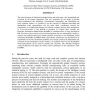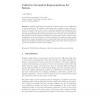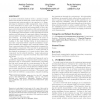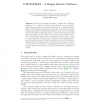131 search results - page 10 / 27 » Designing an Architecture for Adjustably Autonomous Robot Te... |
DAGSTUHL
1994
13 years 8 months ago
1994
The main advantage of distributed controlled robots and subsystems is the decentralized task execution by the system components. This way, properties for the design of flexible co...
DARS
2000
Springer
13 years 11 months ago
2000
Springer
Realistic applications of autonomous Robotics face a lot of difficulties in real environments. To navigate, self-localize and cooperate in such contexts, a multi-robot system has t...
CF
2004
ACM
14 years 25 days ago
2004
ACM
In a future networked physical world, a myriad of smart sensors and actuators assess and control aspects of their environments and autonomously act in response to it. Examples ran...
GECCO
2009
Springer
14 years 1 months ago
2009
Springer
Evolution has proven to be an effective method of training heterogeneous multi-agent teams of autonomous agents to explore unknown environments. Autonomous, heterogeneous agents ...
EPIA
2005
Springer
14 years 27 days ago
2005
Springer
This paper describes Catrapilas, a small robotic platform, designed to be capable of solving some well known robot problems. Among these are some of the most popular robotic contes...




